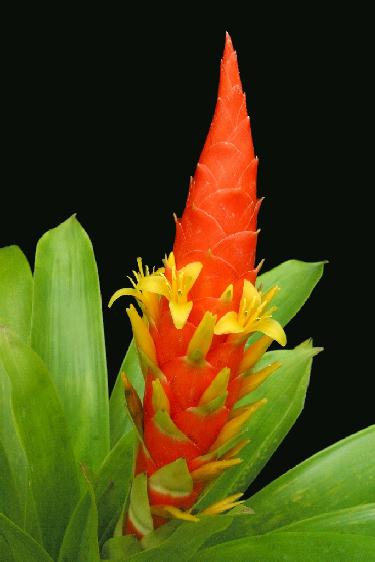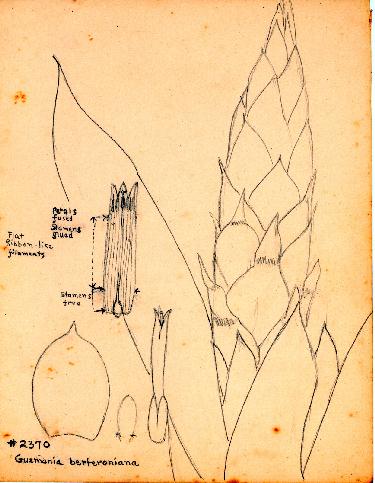

Descriptions below supplied by Derek Butcher.
Guzmania berteroniana (Schultes filius) Mez, DC. Monogr. Phan. 9: 904. 1896, as "berteroana."
Caraguata berteroniana Schultes filius in Roemer & Schultes, Syst. 7(2): 1229. 1830.
Devillea speciosa Bertero ex Schultes filius in Roemer & Schultes, Syst. 7(2): 1229. 1830; in synon.
Tillandsia caraguata D. Dietrich, Syn. Pl. 2: 1059. 1840; nom. illeg.
Caraguata grandiflora Baker, Handb. Brorne1. 145. 1889. Type. Maricao, Puerto Rico, Sintenis 471 (K, K photo 7467; GH, US), 7 Dec 1884.
Desc from S&D
Plant stemless, flowering to 4 dm high.
Leaves many in a dense rosette, about 4 dm long;
sheaths ovate, inconspicuous, obscurely brown-pupctulate-lepidote;
blades ligulate, acute or acuminate, 5 cm wide, pale-green, glabrous.
Scape erect, much shorter than the leaves, glabrous;
scape-bracts erect and densely imbricate, elliptic, the lower ones foliaceous, the upper ones dark-red and bracteiform.
Inflorescence simple, many-flowered, about equaling the leaves, densely cylindric, to 25cm long and 4 cm in diameter, acute, sterile toward apex.
Floral bracts erect, very densely imbricate, much exceeding the sepals, broadly elliptic, the lower acuminate, the upper apiculate, bright-miniate, glabrous, membranaceous; flowers subsessile, to 6 cm long, bright-yellow, definitely exceeding the bracts.
Sepals very broadly elliptic, obtuse, 22 mm long, connate for 2 mm, glabrous, subcoriaceous, striate;
corolla-lobes elliptic, obtuse, subspreading;
stamens 4 mm shorter than the petals.
Capsule subprismatic, acute, 3 cm long; coma white.
Type. Bertero s n (holotype B), without exact locality, Puerto Rico.
DISTRIBUTION. Terrestrial and epiphytic in forest, 390-1200 m alt, Panama, Republica Dominicana, Puerto Rico. PANAMA. COCLE: Cerro Pajita, El Valle, 2Jan 1947, Allen 3957 (MO). REPUBLICA DOMINICANA. SANTIAGO: Loma Diego de Ocarnpo, Cordillera Septentrional, 19 Jul 1929, Ekman H-13210 (S, US); Canca Arriba, 1 Feb 1955, Jimenez 2797 (US). SEIBO: El Siebo to Miches, 12 Apr 1960, Jimenez, Ariza Julia & Marcano 4169 (US). PUERTO RICO. Sierra de Luquillo, Sintenis s n (GH); 13 Apr 1899, Heller 1077 (US); Rio Icaco to Big Falls, Sierra de Naguabo, 16 Jul 1914, Shafer 3173 (NY, US); El Yunque, 5 Jul 1919, Stevenson 2808 (US); 30 Sep 1948, Foster 2370 (US); Guayama to Cayey, 15 Mar 1922, Britton, Britton & Brown 6573 (NY, .US); Maricao, 28 Apr 1935, Sargent 670 (US); without exact locality, 1820, Balbis s n (G); Plee s n (P); Hornbeck s n (C); Sintenis 1577 (M).
Detail from Baker 1889
12. CARAGUATA GRANDIFLORA Baker. -
Leaves densely rosulate, thin, lanceolate, subglabrous, narrowed to the point, 1-1½ ft. long, 1-1½ in. broad at the middle. Peduncle much shorter than the leaves. Inflorescence a dense multifarious spike 3-4 in. long, 1½-2 in. diam.; bracts ovate, bright red, much imbricated, l½-2 in. long, an inch broad. Calyx much shorter than the bract; sepals obtuse. Corolla 1½ in. longer than the calyx, bright yellow; segments linear-oblong, ½ in. long. Anthers linear, ? in. long, not united. Capsule 2 in. long, ? in. diam., tapering to the point.
Hab. Forests of Porto Rico, Sintenis 471 ! 1577 ! 2765 ! 2970 ! Closely resembles G. tricolor and erythrolepis in habit, but the anthers are not united.
A GORGEOUS BROMELIAD by T. H. Everett
A Reprint from "Plant Portraits," Gardener's Chronicle of America, Apri1 1949
In BSIJ 1955 p70-1
The bromeliads or "bromels" as they are sometimes called seem to be gaining popularity among lovers of good indoor plants. Who knows but that they may yet challenge in a modest way the present favor enjoyed by aroids They are a deserving group, attractive in habit and in foliage and given to producing astonishingly beautiful inflorescences. In many species the inflorescence and bracts are as gorgeously colored and as showy or even showier than the flowers themselves; in these instances the duration of the display is an extended one. Such is the case with Guzmania Berteroniana the subject of this present "Plant Portrait," a plant to which no reference is given in "Index Londinensis" and of which I have succeeded in locating but one illustration in botanical literature ( Addisonia Vol. XXII, plate 716. 1944). Yet this species is one of the most splendid of bromeliads. When in bloom in the conservatories of The New York Botanical Garden it invariably draws a full share of acclaim from both botanically-interested and lay visitors. Like a brilliant red-hot poker the astonishing inflorescence thrusts its way upward from the center of a leafy cupped rosette of green.
The glowing vermillion end of the "poker" is a full nine inches long, approximately spindle-shaped with a sharply pointed extremity, and two inches thick at its widest. It is composed of broad overlapping bracts that fit against each other like shingles on a roof but in such fashion that the base of each is hidden beneath the upper part of the next below. The lowermost bracts are green-tipped. From the axil of each bract ( except a very few of the uppermost) a flower is borne and these open in succession from below upwards. The flowers are bright yellow, each with three spreading petals; they measure about an inch across the limb from petal tip to petal tip. When expanded they protrude considerably from the bracts which shelter them as developing buds. The contrast of colors between flowers and bracts is certainly forceful.
The vegetative growth of Guzmania Berteroniana consists of numerous smooth. glossy, green leaves arranged to form a deep, cupped rosette capable of holding water in its lower part and with the upper parts of the leaves flaring outwards. Above the broad ovate base each leaf is strap-shaped and terminates in a short pointed tip. The lower parts of the leaf margins are more or less rolled inwards. Unlike many bromeliads the leaves of this species are not furnished with marginal spines.
The plant is stemless and forms offset shoots which at their bases are clustered tightly together. These afford a ready means of propagation permitting the simple division of the entire plant or the removal of the shoots after they have attained a fair size and their insertion as cuttings in a moist propagation case. I have not observed the seeds myself but E. J. Alexander describes them in the discussion accompanying the" Addisonia" plate and I have no doubt they would provide a most easy means of increase. Seeds of bromeliads germinate readily if sown on sphagnum moss or even on blotting paper kept constantly moist and in a nearly saturated atmosphere such as can be maintained under a bell jar or in a terrarium case.
Guzmanias are epiphytes; they grow well when potted in plain orchid peat but other loose media that permit the free passage of air and water are suitable. A mixture of equal parts peat-moss and sand is satisfactory, so also is a mixture of fibrous turf, orchid peat, partially decayed leaves, broken crocks and charcoal. I do not doubt but that they would be perfectly adaptable to gravel culture in the same way as are certain orchids, but this I have not tried. Like many bromeliads this species revels in high temperatures accompanied by high humidity. Whether it is adaptable as some others to the drier air of a dwelling house or apartment I do not know. It would be an interesting matter for experiment. In any case the cup formed by the bases of the leaves should be kept filled with water.
In its native state Guzmania Berteroniana is confined to the mountain forests of Puerto Rico where it is described as growing on trees and banks. It was first discovered in 1818 or 1819 by one Carlo Guiseppi Bertero after whom it was named. The generic name Guzmania was first applied in 1802 to a species that occurs in South America and in the West Indies (G. Tricolor). now Guzmania monostachia. The botanists Ruiz and Pavon used this name to honour the memory of the eighteenth century Spanish naturalist, Anastasio Guzman. The plants of Guzmania Berteroniana, now in cultivation at The New York Botanical Garden, are descendents by vegetative propagation of specimens obtained in 1915 from Puerto Rico by a late Director-in-Chief of the Garden, Dr.N.L.Britton.
Horticulturalist, New York Botanical Garden, N.Y.